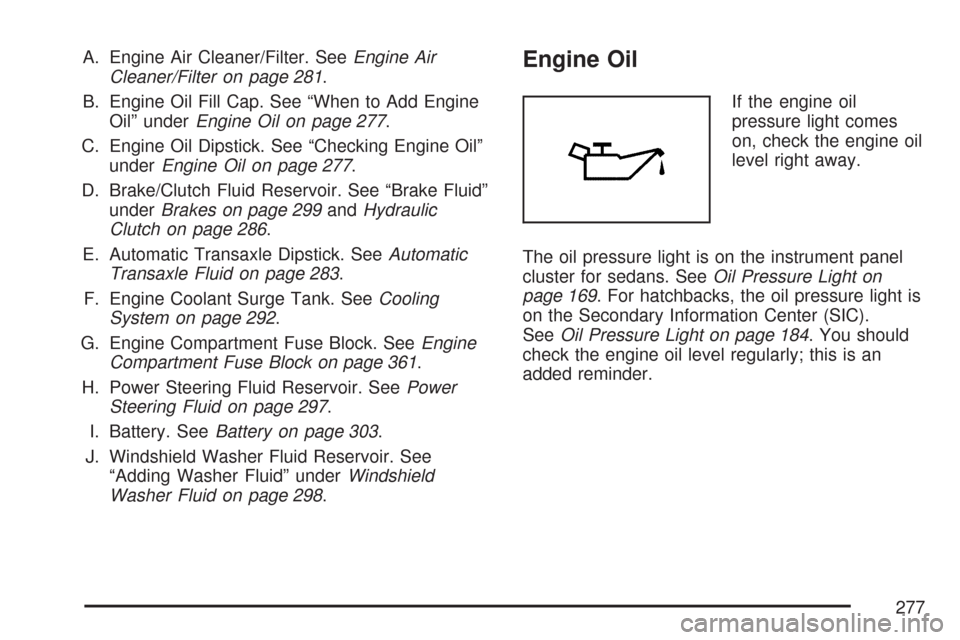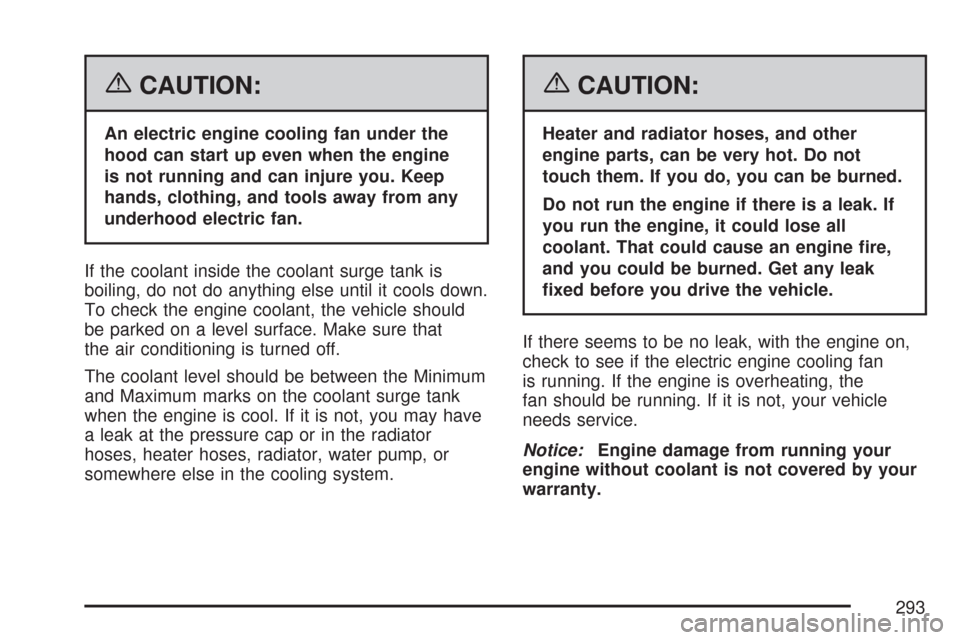Page 277 of 436

A. Engine Air Cleaner/Filter. SeeEngine Air
Cleaner/Filter on page 281.
B. Engine Oil Fill Cap. See “When to Add Engine
Oil” underEngine Oil on page 277.
C. Engine Oil Dipstick. See “Checking Engine Oil”
underEngine Oil on page 277.
D. Brake/Clutch Fluid Reservoir. See “Brake Fluid”
underBrakes on page 299andHydraulic
Clutch on page 286.
E. Automatic Transaxle Dipstick. SeeAutomatic
Transaxle Fluid on page 283.
F. Engine Coolant Surge Tank. SeeCooling
System on page 292.
G. Engine Compartment Fuse Block. SeeEngine
Compartment Fuse Block on page 361.
H. Power Steering Fluid Reservoir. SeePower
Steering Fluid on page 297.
I. Battery. SeeBattery on page 303.
J. Windshield Washer Fluid Reservoir. See
“Adding Washer Fluid” underWindshield
Washer Fluid on page 298.Engine Oil
If the engine oil
pressure light comes
on, check the engine oil
level right away.
The oil pressure light is on the instrument panel
cluster for sedans. SeeOil Pressure Light on
page 169. For hatchbacks, the oil pressure light is
on the Secondary Information Center (SIC).
SeeOil Pressure Light on page 184. You should
check the engine oil level regularly; this is an
added reminder.
277
Page 287 of 436

Engine Coolant
The cooling system in your vehicle is filled with
DEX-COOL®engine coolant. This coolant is
designed to remain in your vehicle for five years
or 150,000 miles (240 000 km), whichever
occurs first, if you add only DEX-COOL
®extended
life coolant.
The following explains your cooling system and
how to add coolant when it is low. If you have
a problem with engine overheating, seeEngine
Overheating on page 290.
A 50/50 mixture of clean, drinkable water and
DEX-COOL
®coolant will:
•Give freezing protection down to
−34°F (−37°C).
•Give boiling protection up to 265°F (129°C).
•Protect against rust and corrosion.
•Help keep the proper engine temperature.
•Let the warning lights and gages work as
they should.
Notice:Using coolant other than DEX-COOL
®
may cause premature engine, heater core,
or radiator corrosion. In addition, the engine
coolant may require changing sooner, at
the �rst maintenance service after each
30,000 miles (50 000 km) or 24 months,
whichever occurs �rst. Any repairs would
not be covered by your warranty. Always
use DEX-COOL
®(silicate-free) coolant in
your vehicle.
287
Page 288 of 436

What to Use
Use a mixture of one-half clean, drinkable water
and one-half DEX-COOL®coolant which will
not damage aluminum parts. If you use this coolant
mixture, you do not need to add anything else.
{CAUTION:
Adding only plain water to your cooling
system can be dangerous. Plain water, or
some other liquid such as alcohol, can
boil before the proper coolant mixture will.
Your vehicle’s coolant warning system is
set for the proper coolant mixture. With
plain water or the wrong mixture, your
engine could get too hot but you would
not get the overheat warning. Your engine
could catch �re and you or others could
be burned. Use a 50/50 mixture of clean,
drinkable water and DEX-COOL
®coolant.Notice:If you use an improper coolant
mixture, your engine could overheat and be
badly damaged. The repair cost would not be
covered by your warranty. Too much water
in the mixture can freeze and crack the engine,
radiator, heater core, and other parts.
If you have to add coolant more than four times a
year, have your dealer check your cooling system.
Notice:If you use extra inhibitors and/or
additives in your vehicle’s cooling system, you
could damage your vehicle. Use only the
proper mixture of the engine coolant listed in
this manual for the cooling system. See
Part D: Recommended Fluids and Lubricants
on page 396for more information.
288
Page 289 of 436
Checking Coolant
The engine coolant surge tank is located in the rear
of the engine compartment on the driver’s side of
the vehicle. SeeEngine Compartment Overview on
page 276for more information on location.
{CAUTION:
Turning the surge tank pressure cap when
the engine and radiator are hot can allow
steam and scalding liquids to blow out
and burn you badly. Never turn the surge
tank pressure cap — even a little — when
the engine and radiator are hot.
To check the engine coolant, the vehicle must be
on a level surface. When your engine is cold,
the coolant level should be between the
Maximum (A) and Minimum (B) marks on the
coolant surge tank. The level rises at engine
operation temperature and drops again when the
engine cools down.
289
Page 290 of 436
Adding Coolant
If you need more coolant, add the proper
DEX-COOL®coolant mixture at the coolant surge
tank, but only when the engine is cool. If the
coolant surge tank is empty, a special fill
procedure is necessary. SeeEngine Overheating
on page 290for instructions on “How to Add
Coolant to the Coolant Surge Tank.”
{CAUTION:
You can be burned if you spill coolant on
hot engine parts. Coolant contains
ethylene glycol, and it will burn if the
engine parts are hot enough. Do not spill
coolant on a hot engine.
When replacing the pressure cap, make sure it is
hand-tight and fully seated.
Coolant Surge Tank Pressure Cap
Notice:If the pressure cap is not tightly
installed, coolant loss and possible engine
damage may occur. Be sure the cap is properly
and tightly secured.
Engine Overheating
You will find a coolant temperature gage on your
vehicle’s instrument panel cluster. SeeEngine
Coolant Temperature Gage on page 165.
290
Page 291 of 436

If Steam Is Coming From Your Engine
{CAUTION:
Steam from an overheated engine can
burn you badly, even if you just open the
hood. Stay away from the engine if you
see or hear steam coming from it. Just
turn it off and get everyone away from the
vehicle until it cools down. Wait until
there is no sign of steam or coolant
before you open the hood.
If you keep driving when your engine is
overheated, the liquids in it can catch �re.
You or others could be badly burned.
Stop your engine if it overheats, and get
out of the vehicle until the engine is cool.
Notice:If your engine catches �re because
you keep driving with no coolant, your vehicle
can be badly damaged. The costly repairs
would not be covered by your warranty.
If No Steam Is Coming From
Your Engine
If you get an engine overheat warning, but see or
hear no steam, the problem may not be too
serious. Sometimes the engine can get a little too
hot when you:
•Climb a long hill on a hot day.
•Stop after high-speed driving.
•Idle for long periods in traffic.
If you get the overheat warning with no sign of
steam, try this for a minute or so:
1. In heavy traffic, let the engine idle in
NEUTRAL (N) while stopped. If it is safe to do
so, pull off the road, shift to PARK (P) or
NEUTRAL (N) and let the engine idle.
2. Turn on your heater to full hot at the highest fan
speed and open the windows as necessary.
If you no longer have the overheat warning, you
can drive. Just to be safe, drive slower for
about 10 minutes. If the warning does not come
back on, you can drive normally.
291
Page 292 of 436
If the warning continues and you have not
stopped, pull over, stop, and park your vehicle
right away.
If there is still no sign of steam, you can idle the
engine for three minutes while you are parked.
If you still have the warning, turn off the engine
and get everyone out of the vehicle until it
cools down.
You may decide not to lift the hood, but to get
service help right away.Cooling System
When you decide it is safe to lift the hood, here is
what you will see:
A. Coolant Surge Tank with Pressure Cap
B. Electric Engine Cooling Fan
292
Page 293 of 436

{CAUTION:
An electric engine cooling fan under the
hood can start up even when the engine
is not running and can injure you. Keep
hands, clothing, and tools away from any
underhood electric fan.
If the coolant inside the coolant surge tank is
boiling, do not do anything else until it cools down.
To check the engine coolant, the vehicle should
be parked on a level surface. Make sure that
the air conditioning is turned off.
The coolant level should be between the Minimum
and Maximum marks on the coolant surge tank
when the engine is cool. If it is not, you may have
a leak at the pressure cap or in the radiator
hoses, heater hoses, radiator, water pump, or
somewhere else in the cooling system.
{CAUTION:
Heater and radiator hoses, and other
engine parts, can be very hot. Do not
touch them. If you do, you can be burned.
Do not run the engine if there is a leak. If
you run the engine, it could lose all
coolant. That could cause an engine �re,
and you could be burned. Get any leak
�xed before you drive the vehicle.
If there seems to be no leak, with the engine on,
check to see if the electric engine cooling fan
is running. If the engine is overheating, the
fan should be running. If it is not, your vehicle
needs service.
Notice:Engine damage from running your
engine without coolant is not covered by your
warranty.
293